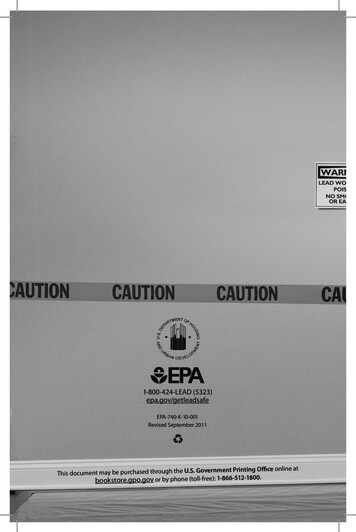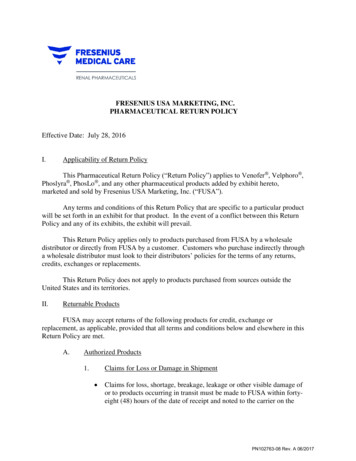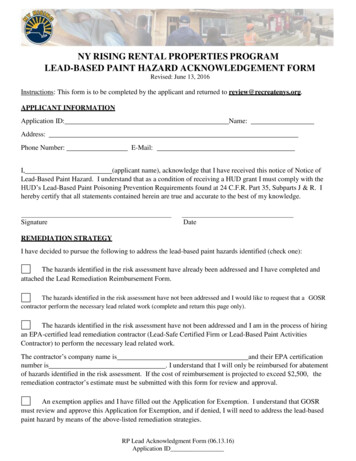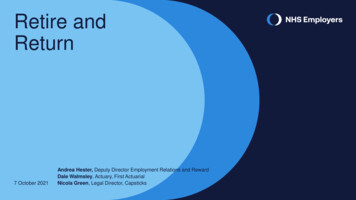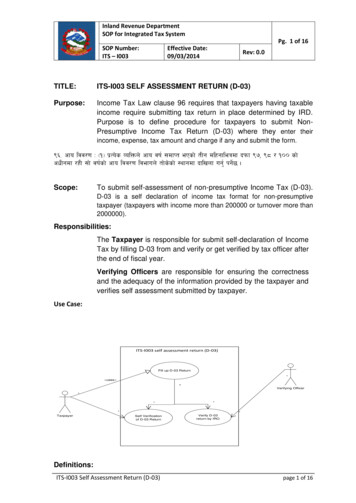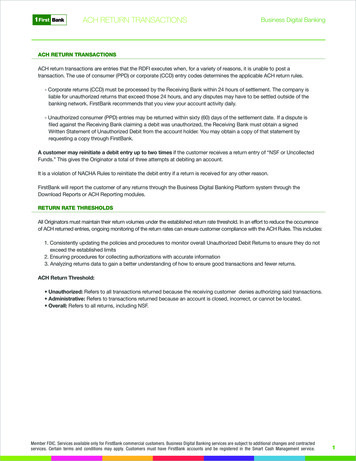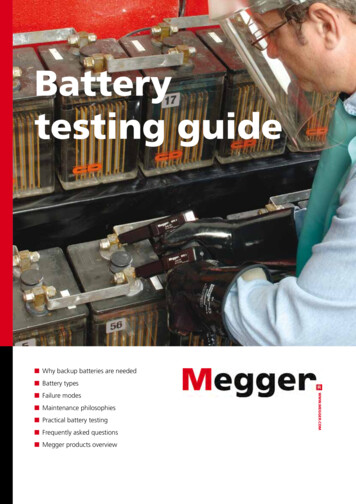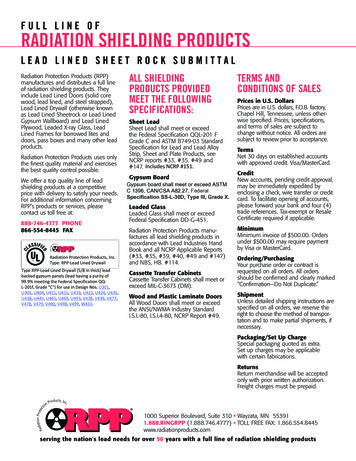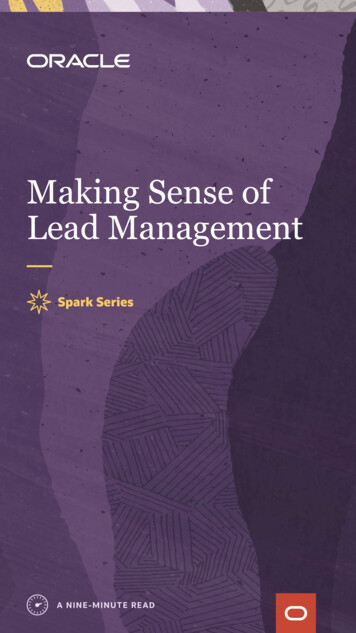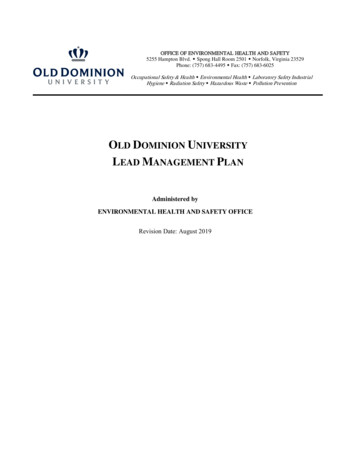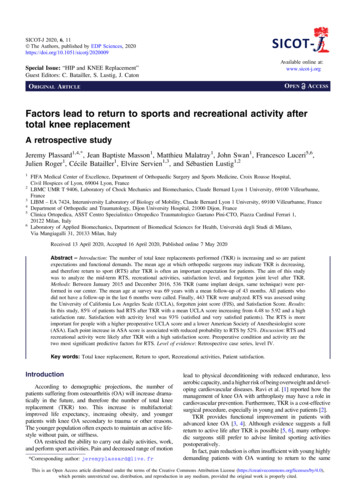
Transcription
SICOT-J 2020, 6, 11Ó The Authors, published by EDP Sciences, e online at:www.sicot-j.orgSpecial Issue: “HIP and KNEE Replacement”Guest Editors: C. Batailler, S. Lustig, J. CatonORIGINAL ARTICLEOPENACCESSFactors lead to return to sports and recreational activity aftertotal knee replacementA retrospective studyJeremy Plassard1,4,*, Jean Baptiste Masson1, Matthieu Malatray1, John Swan1, Francesco Luceri5,6,Julien Roger1, Cécile Batailler1, Elvire Servien1,3, and Sébastien Lustig1,2123456FIFA Medical Center of Excellence, Department of Orthopaedic Surgery and Sports Medicine, Croix Rousse Hospital,Civil Hospices of Lyon, 69004 Lyon, FranceLBMC UMR T 9406, Laboratory of Chock Mechanics and Biomechanics, Claude Bernard Lyon 1 University, 69100 Villeurbanne,FranceLIBM – EA 7424, Interuniversity Laboratory of Biology of Mobility, Claude Bernard Lyon 1 University, 69100 Villeurbanne, FranceDepartment of Orthopedic and Traumatology, Dijon University Hospital, 21000 Dijon, FranceClinica Ortopedica, ASST Centro Specialistico Ortopedico Traumatologico Gaetano Pini-CTO, Piazza Cardinal Ferrari 1,20122 Milan, ItalyLaboratory of Applied Biomechanics, Department of Biomedical Sciences for Health, Università degli Studi di Milano,Via Mangiagalli 31, 20133 Milan, ItalyReceived 13 April 2020, Accepted 16 April 2020, Published online 7 May 2020Abstract – Introduction: The number of total knee replacements performed (TKR) is increasing and so are patientexpectations and functional demands. The mean age at which orthopedic surgeons may indicate TKR is decreasing,and therefore return to sport (RTS) after TKR is often an important expectation for patients. The aim of this studywas to analyze the mid-term RTS, recreational activities, satisfaction level, and forgotten joint level after TKR.Methods: Between January 2015 and December 2016, 536 TKR (same implant design, same technique) were performed in our center. The mean age at survey was 69 years with a mean follow-up of 43 months. All patients whodid not have a follow-up in the last 6 months were called. Finally, 443 TKR were analyzed. RTS was assessed usingthe University of California Los Angeles Scale (UCLA), forgotten joint score (FJS), and Satisfaction Score. Results:In this study, 85% of patients had RTS after TKR with a mean UCLA score increasing from 4.48 to 5.92 and a highsatisfaction rate. Satisfaction with activity level was 93% (satisfied and very satisfied patients). The RTS is moreimportant for people with a higher preoperative UCLA score and a lower American Society of Anesthesiologist score(ASA). Each point increase in ASA score is associated with reduced probability to RTS by 52%. Discussion: RTS andrecreational activity were likely after TKR with a high satisfaction score. Preoperative condition and activity are thetwo most significant predictive factors for RTS. Level of evidence: Retrospective case series, level IV.Key words: Total knee replacement, Return to sport, Recreational activities, Patient satisfaction.IntroductionAccording to demographic projections, the number ofpatients suffering from osteoarthritis (OA) will increase dramatically in the future, and therefore the number of total kneereplacement (TKR) too. This increase is multifactorial:improved life expectancy, increasing obesity, and youngerpatients with knee OA secondary to trauma or other reasons.The younger population often expects to maintain an active lifestyle without pain, or stiffness.OA restricted the ability to carry out daily activities, work,and perform sport activities. Pain and decreased range of motion*Corresponding author: jeremyplassard@live.frlead to physical deconditioning with reduced endurance, lessaerobic capacity, and a higher risk of being overweight and developing cardiovascular diseases. Ravi et al. [1] reported how themanagement of knee OA with arthroplasty may have a role incardiovascular prevention. Furthermore, TKR is a cost-effectivesurgical procedure, especially in young and active patients [2].TKR provides functional improvement in patients withadvanced knee OA [3, 4]. Although evidence suggests a fullreturn to active life after TKR is possible [5, 6], many orthopedic surgeons still prefer to advise limited sporting activitiespostoperatively.In fact, pain reduction is often insufficient with young highlydemanding patients with OA wanting to return to the sameThis is an Open Access article distributed under the terms of the Creative Commons Attribution License h permits unrestricted use, distribution, and reproduction in any medium, provided the original work is properly cited.
2J. Plassard et al.: SICOT-J 2020, 6, 11Figure 1. Flowchart of the study (RTKR: revision TKR).pre-arthritic level of sport. These patients do not only aim forpain relief after TKR. With innovative surgical techniques andmore anatomical implants, TKR is now indicated in youngerpatients with higher sports expectations after TKR [7]. Nowadays it is becoming more important to be able to predict the levelof postoperative sport activity for each specific patient. Bullenset al. [4] and Nobel et al. [8] compared subjective and objectiveoutcomes after TKR, and notably, satisfaction depends on preoperative expectations, which are correlated with objectiveresults.The aim of this study was to analyze the mid-term return tosport (RTS) and recreational activities, satisfaction level, andforgotten joint level, and to find preoperative factors associatedto better functional outcomes after TKR, then, to know whetherthese factors could allow a better preoperative information topatients about RTS and expected activities after TKR.Material and methodsStudy designThere were 536 patients enrolled in this retrospective studywho underwent TKR between January 2015 and December2016. Surgery was performed using the same primary highflexion posterior-stabilized cemented implant (AnatomicÓ,Amplitude, France).TKR was performed without tourniquet using the samesurgical technique by four different senior surgeons. A medialparapatellar trans-quadricipital approach was performed forvarus knees and the Keblish lateral approach was performedfor valgus knees. The patella was resurfaced only when severepatellar osteoarthritis was present. An immediate full-weightbearing rehabilitation protocol was used with thromboembolicprophylaxis postoperatively for 30 days in all patients.The inclusion criteria were primary TKR for symptomaticknee osteoarthritis. A total of 536 TKR were performed betweenJanuary 2015 and December 2016. The exclusion criteria were:revision TKR, inflammatory osteoarthritis, neuromuscularconditions (Parkinson’s disease, Alzheimer’s disease, stroke),or conditions that may interfere with the standard postoperativerehabilitation protocol. We excluded 15 revision TKR,16 patients with neurological or musculoskeletal disorders and23 deaths at the time of final follow-up. All patients withoutclinical follow-up in the last 6 months were evaluated using afunctional questionnaire. Finally 39 patients (7%) were lost toTable 1. Sample characteristics and outcomes.Age (years)Age 65 yoAge 65 yoGenderMaleFemaleBMIKnee surgery beforeMedial meniscectomyArticular washingHTOACL ligamentoplastyLateral meniscectomyTibial plate fractureTemporal fractureDFOVarus deformityValgus deformityNormoaxisIKS objectiveUCLA 4UCLA 4–6UCLA 669 (41–90)146 (41–65)297 (66–90)162 (36.6%)281 (63.4%)29.3 (19–46)58 (13%)38 (8.5%)32 (7%)27 (6%)24 (5.5%)10 (2.2%)4 (1%)1 (0.2%)311 (70%)87 (20%)45 (10%)47119 (27%)289 (65%)35 (8%)follow-up (non-responders or contact details where changed).Four hundred and forty three TKR were included in the study.Patient flow-chart is presented in Figure 1 and demographiccharacteristics are summarized in Table 1. The mean followup in this study was 43 months [23–49 months].Patients completed the questionnaire at 2 months, 1-yearfollow-up, and every 2 years postoperatively. Before surgeryactivity level was assessed using the UCLA score [3, 9] andsport type by direct question. All patients who did not haveface-to-face consultation in 2019 were called. We analyzedthe postoperative UCLA score: activity level: low ( 3), moderate (4–6), and high ( 7) [10]. RTS after surgery (in months),type of sport most frequently performed after surgery, forgottenjoint score (FJS) [11] and a satisfaction score (very satisfied,satisfied, disappointed, dissatisfied) based on the new IKS score[12] were also collected in the study.Statistical analysisPatient demographics were described using means and standard deviations or medians and ranges for continuous variables
J. Plassard et al.: SICOT-J 2020, 6, 113and percentage counts for categorical variables. The study sample was divided into four sub-groups according to sex and age:younger group (age 65 yo) and older group (age 65 yo).Preoperative and postoperative sport level, RTS, FJS, and thelevel of satisfaction were compared between groups. A multivariate linear regression analysis was performed to assesspossible relationships between return to sport and the includedvariables: age at time of surgery, ASA score, sex, body massindex (BMI), preoperative UCLA group (low, moderate, orhigh), type of deformity (neutral, varus, or valgus alignmentgroups), degree of deformity, and patellar resurfacing. We useda generalized binomial linear logistic model produced underR Commander for multivariate analysis.ResultsReturn to sportA total of 376 patients (85%) returned to sport after TKR,240 women (85%) and 136 men (84%). This represents 88%patients in the 65 yo group (129 patients) and 83% in the 65 yo group (247 patients). The mean delay to RTS was5 months [1–36 months], with 33% of the patients returningto sport or activities within 3 months postoperatively and81% of the patients within 6 months postoperatively.Figure 2. Pre- and post-operative UCLA score with activity level.Predictive factors to RTSMultivariate analysis shows a significant difference inreturn to sport according to preoperative UCLA scores(p 0.001). Patients with a higher preoperative UCLA scorehad a higher RTS rate. A higher ASA score was a negative predictive factor for RTS (p 0.005), with each increase in ASAof one point being associated with a reduction of RTS probability by 52%. There were no significant differences in age, sex,BMI (p 0.054), severity of preoperative knee deformity,previous knee surgery history, and patellar resurfacing.Level of activity: UCLAAll patients were divided into three groups for activity level:low activity group (UCLA score 3), moderate group (UCLAscore 4–6), and high active group (UCLA scale 7) (Figure 2);and in two groups for sex and age: 65 years and 65 years(Figure 3). The mean preoperative UCLA score was 4.45 andthe mean postoperative UCLA score was 5.92, the mean UCLAactivity score increased by 1.47 point. Compared to preoperativeUCLA scores, 357 patients (80%) had a significant postoperative improvement, 64 patients (14%) achieved the same score,and 22 patients (5%) had a decreased UCLA score (1–3 UCLApoints). After TKR, 82% of patients declared being RTS orrecreational activities, with only 67 patients declaring restrictionin their daily activities due to their TKR.Satisfaction and forgotten joint score (FJS)At the last follow-up, the satisfaction rate after TKR wasimportant. Four hundred and twelve patients reported that theyFigure 3. Pre- and post-operative UCLA score with age.were satisfied or very satisfied (93%), 17 were moderately satisfied (4%), and 15 were unsatisfied (3%). Unsatisfied patientshad a lower FJS level, down to 25/100 and only 12 patientsreturned to sport. 344 patients (77%) had a FJS higher than75/100 and no limitations in physical activity and their satisfaction rate was up to 38/40. There were no significative differences in postoperative satisfaction between gender and age.Sport disciplinesThe most frequently performed activities were walking, hiking, gardening, swimming, yoga, cycling, and playing golf(Table 2). Three hundred and seventy six patients wereinvolved in sports activities, 326 patients (86.9%) reportedachieving a higher level. 39 patients reported being at the samelevel (10.3%) and 11 patients (3%) at a lower level compared topreoperative levels. Low-impact activities such as walking,hiking, cycling, or swimming were performed more aftersurgery and we found a decrease in high-impact activities such
J. Plassard et al.: SICOT-J 2020, 6, 114Table 2. Variation in types of sport ncingRunningClimbingPre operative208 (46.9%)106 (23.9%)47 (10.6%)50 (11.3%)48 (10.8%)26 (5.8%)28 (6.3%)11 (2.4%)6 (1.3%)4 (0.9%)5 (1.2%)04 (0.9%)1 (0.3%)Post operative263 (59.3%)120 (27.0%)56 (12.6%)55 (12.4%)54 (12.2%)32 (7.2%)23 (5.2%)9 (2.0%)6 (1.3%)5 (1.2%)3 (0.7%)2 (0.5%)1 (0.3%)1 (0.3%)as tennis, jogging, or skiing. Patients with a lower level ofsporting activity cited reasons such as precautionary avoidanceto preserve their TKR (nine patients), knee pain (sevenpatients), general health condition, two patients with the sensation of knee instability, and two patients with periprostheticinfection.Range of motion evolutionWe analyzed for an association between range of motion(ROM) and patient satisfaction. In unsatisfied, low-satisfied,and satisfied groups, the range of motion decreased afterTKR: from 117 to 109 for unsatisfied patients, from 122 to 114 for low-satisfied patients, and from 125 to 122 forsatisfied patients. Only highly satisfied patients had an increasein ROM after TKR from 120 to 122 .ComplicationsThere were eight TKR revision surgeries: two for asepticloosening, three for prosthetic joint infection (PJI), two patellarrevisions for lateral patellar instability, and one for patellarclunk syndrome. Five of the eight patients who required revision surgery managed to return to sports prior to revision.DiscussionThe principle finding of this study was that most patientsreturned to sport by 6 months postoperatively (80%), with asignificantly higher UCLA score than prior to surgery. Therefore, patients should expect participation in sports activitiesafter TKR.The most reliable predictive factors of RTS after TKR arepreoperative UCLA and ASA scores and, contrary to other published studies (15, 16, 20), age, gender, and BMI appear not toinfluence the RTS. The absolute number of sports practiced bypatients pre- and postoperatively was similar; however, therewas a change in types of physical activities. This study wasnot the first to evaluate the RTS after TKR, but it is one ofthe largest and with long-term follow-up. Ten studies were usedto compare to our series (Table 3). These studies had a meanfollow-up 1 year, more than 100 patients (except [13]), andmeta-analysis. Bradbury et al. [14] reported that 77% of patientswho participated in sport preoperatively returned to sportpostoperatively with or without adaptation of activities. Morerecently, Chatterji et al. [15] reported that 75% of patientsreturned to sports activities after 1 year.Mean postoperative UCLA score was comparable to thestudy by Bauman et al. [16] who found a mean score of 6.0in a series of 184 TKR. Dahm et al. [3] reported a mean scoreof 7.1 with 74% of patients engaged in activities at a mean of5.7 years after arthroplasty, with 16% of the patients reportingparticipating in heavy manual labor or sports deemed “notrecommended” by the Knee Society survey [6].Chatterji et al. [15] and Wylde et al. [17] have found,patients who underwent TKR reduced the intensity of highimpact activities such as jogging, skiing, or tennis, whileincreasing low-impact activities such as walking, hiking,cycling, or swimming. In a systematic review, Witjes et al.[18] reported that RTS for TKR varied from 36% to 89%, withmean total numbers of postoperative sports of 0.2–1.0 sportswith a mean of 13 weeks for RTS.There is no evidence of any correlation between high-levelsports and early implant loosening, bearing surface wear orpremature revision. Although some surgeons discourage highimpact sport, in contrast, Mont et al. [19] showed that highlevel tennis players returned to tennis after TKR. Healy et al.[6] reported limited evidence-based information on implantsurvival after sport to make recommendations where patientsare recommended to avoid high-impact sports. In our study147 patients (33%) participated in high-impact sport withoutimplant failure. Therefore, if patients understand the risks associated with their activities and choose to return to sport, surgeonshould not discourage their patients. Kersten et al. [20] showedthat almost half of patients who underwent TKR did not meethealth-enhancing physical activities guidelines. In a study byWalker et al. [21] of patients with lateral unicompartmentalknee replacements (UKR), the majority of patients decreasedtheir activities to protect their UKR. In our series of patientswith TKR, activity restriction because of the TKR occurredin only 22 patients for reasons of pain, knee instability, orlimited range of motion.Hopper and Leach [13] compared UKR to TKR, whereUKR had superior results and they found that patients withTKR returned to low-impact sport. In the TKR group, 63.4%returned to sport by 4.1 months with a significant reductionin playing bowls and golf postoperatively. In active golfers,Mallon and Callaghan [22] found that the players’ handicapincreased significantly and their driving distance was substantially reduced. Jones et al. [23] did not show an increase in revision rates due to high-impact activities at midterm follow-up.Bonnin et al. [24] have shown how satisfaction depends uponpreoperative patient expectations. In our study, we have a highpercentage of patients that are satisfied or very satisfied (92%)with a mean Forgotten Joint Score of 82/100. This demonstratesthe improvement in quality of life as a result of TKR, which isconfirmed by other studies [25].
J. Plassard et al.: SICOT-J 2020, 6, 115Table 3. Return to sport after TKR, data extracted from studies included in the review (10 studies).StudyUCLASatisfiedMean postoperative progression and verysatisfiedUCLA6––––83%Study designMeanfollow-upStudypopulationRTSTime toRTSBauman et al. [16]Bonnin et al. [24]Cross-sectional surveyCross-sectional survey36.6 month44 month184 patients347 patients––Bradbury et al. [14]Chang et al. [10]Chatterji et al. [15]Cross-sectional surveyRetrospective studyCross-sectional survey5 years2 yearsBetween1 and 2 years5.7 years21.6 months 1 yearVariable 3 years160 patients369 patients144 patients–56% group 75 yo77%76%75%––––4.8–– 0.3––––1206 patients76 patients253 patients18 studies866 patients–63%–36–89%73%–––12 3%75%––Dahm et al. [3]Cross-sectional surveyHopper and Leach [13] Cross-sectional surveyNoble et al. [8]Cross-sectional surveyWitjes et al. [18]Systematic reviewWylde et al. [17]Cross-sectional surveyThis study has several limitations. Firstly, this work is aretrospective study, with a low level of evidence. Secondly,7% of patients were lost to follow-up, and we could not assessif these patients were still alive or if they underwent revisionsurgery. In a similar study, Chang et al. [10] had a response rateof just 65%. Thirdly, the mean follow-up in this study was43 months, which is adequate to determine early satisfactionoutcomes, activity levels and time to RTS, but not long enoughto evaluate revision rates, wear, and loosening.Total knee arthroplasty is an effective treatment for painrelief; functional improvement and RTS is likely after TKRwith a high satisfaction score. Preoperative condition andactivity are the two most significant predictive factors forRTS. After TKR, patients should be encouraged to maintainphysical activities with individual adaptions based upon generalhealth, preoperative activity level, and type of preoperativesport. Then, surgeons should explain to the patient what kindof activities they can participate in after TKR and how to adjusttheir activities and give more details on expected results according to patients’ preoperative status and health.Conflicts of interestJP, JBM, MM, JS, FL, JR, CB, and ES declare that theyhave no conflict of interest with this study. SL declares thefollowing conflicts of interest: consulting (Smith and Nephew,Stryker, Groupe Lepine, Aeraeus, Medacta, Amplitude, Corin),institutional research support to Corin and Amplitude.References1. Ravi B, Croxford R, Austin PC, et al. (2014) The relationbetween total joint arthroplasty and risk for serious cardiovascular events in patients with moderate-severe osteoarthritis:Propensity score matched landmark analysis. Br J Sports Med48, 1580.2. Bedair H, Cha TD, Hansen VJ (2014) Economic benefit tosociety at large of total knee arthroplasty in younger patients: AMarkov analysis. J Bone Joint Surg Am 96, 119–126.3. Dahm DL, Barnes SA, Harrington JR, et al. (2008) Patientreported activity level after total knee arthroplasty. J Arthroplasty 23, 401–407.4. Bullens PH, van Loon CJ, de Waal Malefijt MC, et al. (2001)Patient satisfaction after total knee arthroplasty: A comparisonbetween subjective and objective outcome assessments.J Arthroplasty 16, 740–747.5. Swanson EA, Schmalzried TP, Dorey FJ (2009) Activityrecommendations after total hip and knee arthroplasty: Asurvey of the American Association for Hip and Knee Surgeons.J Arthroplasty 24, 120–126.6. Healy WL, Iorio R, Lemos MJ (2000) Athletic activity aftertotal knee arthroplasty. Clin Orthop Relat Res 90, 65–71.7. Crowninshield RD, Rosenberg AG, Sporer SM (2006) Changing demographics of patients with total joint replacement. ClinOrthop Relat Res 443, 266–272.8. Noble PC, Conditt MA, Cook KF, Mathis KB (2006) The JohnInsall Award: Patient expectations affect satisfaction with totalknee arthroplasty. Clin Orthop Relat Res 452, 35–43.9. Naal FD, Impellizzeri FM, Leunig M (2009) Which is the bestactivity rating scale for patients undergoing total jointarthroplasty? Clin Orthop Relat Res 467, 958–965.10. Chang MJ, Kim SH, Kang YG, et al. (2014) Activity levels andparticipation in physical activities by Korean patients followingtotal knee arthroplasty. BMC Musculoskelet Disord 15, 240.11. Behrend H, Giesinger K, Giesinger JM, Kuster MS (2012)The “Forgotten Joint” as the ultimate goal in joint arthroplasty.J Arthroplasty 27, 430–436.e1.12. Scuderi GR, Bourne RB, Noble PC, et al. (2012) The new kneesociety knee scoring system. Clin Orthop Relat ResÒ 470, 3–19.13. Hopper GP, Leach WJ (2008) Participation in sporting activitiesfollowing knee replacement: Total versus unicompartmental.Knee Surg Sports Traumatol Arthrosc 16, 973–979.14. Bradbury N, Borton D, Spoo G, Cross MJ (1998) Participationin sports after total knee replacement. Am J Sports Med 26,530–535.15. Chatterji U, Ashworth MJ, Lewis PL, Dobson PJ (2005) Effectof total knee arthroplasty on recreational and sporting activity.ANZ J Surg 75, 405–408.16. Bauman S, Williams D, Petruccelli D, et al. (2007) Physicalactivity after total joint replacement: A cross-sectional survey.Clin J Sport Med 17, 104–108.
6J. Plassard et al.: SICOT-J 2020, 6, 1117. Wylde V, Blom A, Dieppe P, et al. (2008) Return to sport afterjoint replacement. J Bone Joint Surg Br 90, 920–923.18. Witjes S, Gouttebarge V, Kuijer PPFM, et al. (2016) Return tosports and physical activity after total and unicondylar kneearthroplasty: A systematic review and meta-analysis. SportsMed 46, 269–292.19. Mont MA, Marker DR, Seyler TM, et al. (2008) High-impactsports after total knee arthroplasty. J Arthroplasty 23, 80–84.20. Kersten RFMR, Stevens M, van Raay JJAM, et al. (2012)Habitual physical activity after total knee replacement. PhysTher 92, 1109–1116.21. Walker T, Gotterbarm T, Bruckner T, et al. (2015) Return tosports, recreational activity and patient-reported outcomes afterlateral unicompartmental knee arthroplasty. Knee Surg SportsTraumatol Arthrosc 23, 3281–3287.22. Mallon WJ, Callaghan JJ (1993) Total knee arthroplasty inactive golfers. J Arthroplasty 8, 299–306.23. Jones DL, Cauley JA, Kriska AM, et al. (2004) Physical activityand risk of revision total knee arthroplasty in individuals withknee osteoarthritis: A matched case-control study. J Rheumatol31, 1384–1390.24. Bonnin M, Laurent JR, Parratte S, et al. (2010) Can patientsreally do sport after TKA? Knee Surg Sports TraumatolArthrosc 18, 853–862.25. Ethgen O, Bruyère O, Richy F, et al. (2004) Health-relatedquality of life in total hip and total knee arthroplasty. Aqualitative and systematic review of the literature. J Bone JointSurg Am 86, 963–974.Cite this article as: Plassard J, Masson J, Malatray M, Swan J, Luceri F, Roger J, Batailler C, Servien E & Lustig S (2020) Factors lead toreturn to sports and recreational activity after total knee replacement. SICOT-J 6, 11
the University of California Los Angeles Scale (UCLA), forgotten joint score (FJS), and Satisfaction Score. Results: In this study, 85% of patients had RTS after TKR with a mean UCLA score increasing from 4.48 to 5.92 and a high satisfaction rate. Satisfaction with activity level was 93% (satisfied and very satisfied patients). The RTS is more
